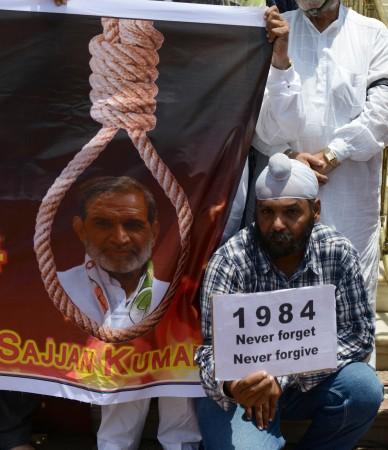
Former Congress leader Sajjan Kumar on Monday moved the Supreme Court seeking an early hearing on his bail plea in 1984 anti-Sikh riots case. Kumar's counsel and senior advocate Shekhar Naphade brought up the plea before a bench headed by Chief Justice Ranjan Gogoi, who said the bench will consider it. In December 2018, Kumar was convicted in a 1984 anti-Sikh riots case by the Delhi High Court and was sentenced to life imprisonment. He had challenged the order in the Supreme Court and sought bail, the plea for which is still pending.
Sajjan Kumar and five others were tried for instigating a mob that killed Kehar Singh, Gurpreet Singh, Raghuvender Singh, Narender Pal Singh and Kuldeep Singh — all members of a family — in Delhi Cantonment's Raj Nagar area following the assassination of Indira Gandhi on October 31, 1984. The case against Sajjan Kumar and others was registered in 2005 on a recommendation by the Justice G.T. Nanavati Commission.
The 1984 anti-Sikh riots took place after then prime minister Indira Gandhi was shot dead by her Sikh bodyguards at her official residence on October 31 that year, but cases pertaining to it are still running in the Supreme Court, over 32 years later. The apex court on Monday (March 6) asked the Special Investigation Team (SIT) looking into the case about its progress.
5 things you need to know about the Anti-Sikh 1984 riots:

1. The Khalistan movement, Operation Blue Star and Indira Gandhi's assassination
There had been demand for a separate Khalistan for quite some time in India, and it crystallised into what we now know as the Khalistan movement. When the Khalistan took refuge in the Golden Temple in Amritsar and started building military strength, Indira Gandhi sent the Army to take them out in what has since become known as Operation Blue Star. The Sikhs did not take kindly to the desecration of the holy precinct in the attack, and it eventually led to her Sikh bodyguards Satwant Singh and Beant Singh assassinating Indira on October 31, 1984.
2. Four days of carnage
The anti-Sikh riots that broke out after Indira's death lasted four days — from October 31 to November 3. The first murder of a Sikh took place on November 1, and the carnage abated only after the police and the Army took to the streets on November 3. Even the then President Zail Singh — also a Sikh — was targetted. His convoy was attacked by irate Congress supporters.
![In picture: 1984 Anti-Sikh Riots. [File Photo] 1984 Anti-Sikh Riots](https://data1.ibtimes.co.in/en/full/637942/1984-anti-sikh-riots.jpg?w=637&h=427&l=50&t=40)
3. Thousands dead with alleged Congress collusion
Though officially the number of Sikhs who died in the riots was pegged at around 2,800 at the time — of which 2,100 were in Delhi alone — unofficial figures showed it as high as 8,000. The riots had started on October 31, but on that day mobs only pulled people out of houses and vehicles and thrashed them. However, Congress leaders like Sajjan Kumar was accused of organising mobs from November 1 and egging them on to kill Sikhs.
4. Use of official documents to identify Sikhs
The extent of Congress' collusion in the riots was to such an extent that party leaders allegedly handed over voter lists and ration lists to members of the mob, with which they could identify Sikh dwellings and attack people from the community. It later emerged that many of the rioters visited the houses of Sikhs and wrote and "S" on their doors so that they could be identified during the day. In some cases, Congress leaders were also accused of reading out names and addresses to illiterate rioters, and even directing them to homes of the Sikhs.
5. Rajiv Gandhi's remarks on riots
Indira Gandhi's death and son Rajiv's elevation to the post of the prime minister was announced simultaneously. Rajiv, later at a public rally, said about his mother's death and the subsequent anti-Sikh riots: "When a big tree falls, the earth shakes." It is often seen as his attempt to justify the riots.

















